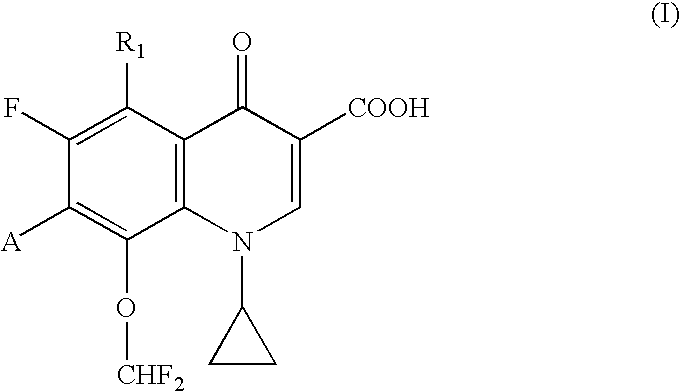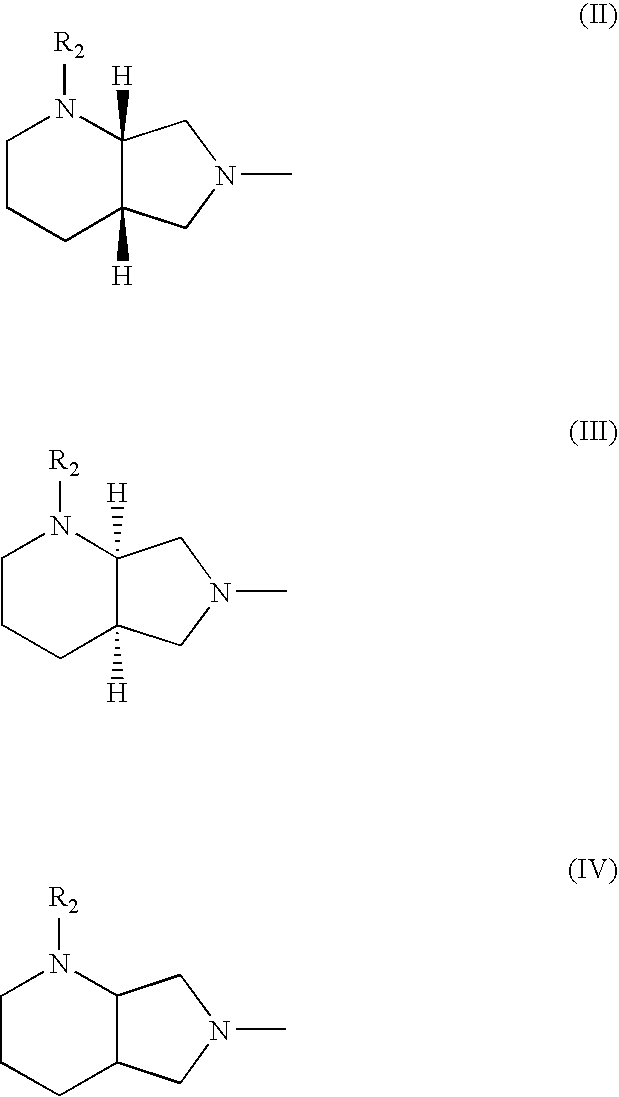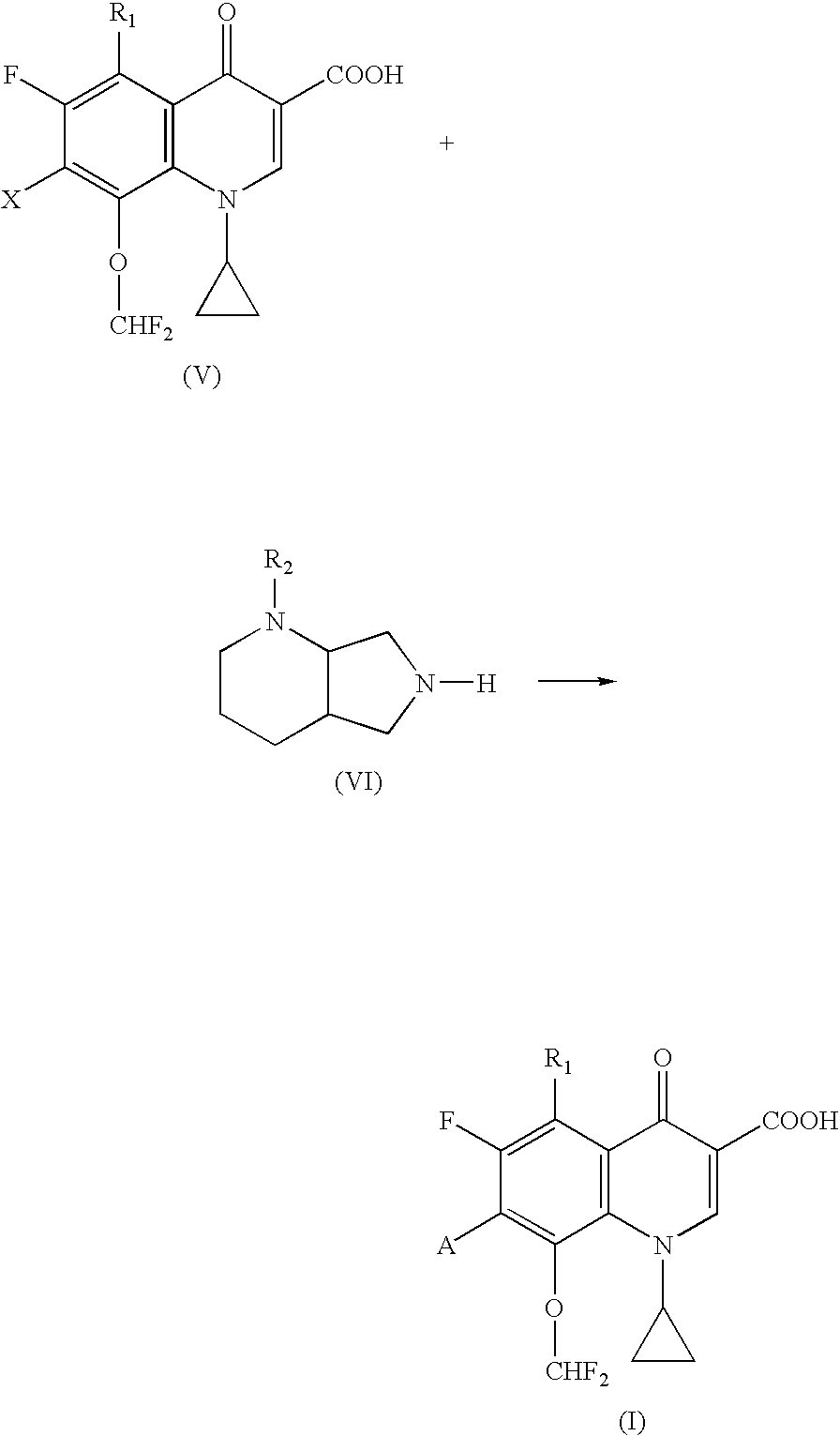Quinolonecarboxylic acid compounds, preparation methods and pharmaceutical uses thereof
- Summary
- Abstract
- Description
- Claims
- Application Information
AI Technical Summary
Benefits of technology
Problems solved by technology
Method used
Image
Examples
embodiment 1
Preparation of 1-Cyclopropyl-6,7-difluoro-8-hydroxyl-1,4-dihydro-4-oxoquinoline-3-carboxylic acid
[0054] The preparation comprises dissolving Ethyl 1-cyclopropyl-6,7-difluoro-8-methoxy-1,4-dihydro-4-oxoquinoline-3-carboxylate (10.0 g, 30.9 mmol) in 40% HBr aqueous solution (20 mL) and acetic acid (20 mL) to react at 100° C., charging reaction mixture into ice water (500 mL) under fast stirring after the reaction finishes, going on with the stirring for 0.5 h, filtering, and drying obtained filter cake to give 1-cyclopropyl-6,7-difluoro-8-hydroxy-1,4-dihydro-oxoquinoline-3-carboxylic acid (7.8 g, 89.6%).
[0055]1H NMR(DMSO) δ=1.01-1.27(4H, m), 4.25-4.33(1H, m), 7.67(1H, dd, J=8.1 Hz, J=12.6 Hz), 8.68(1H, s), 11.64(1H, s), 14.71(1H, br.). MS(m / z): 282(M++1).
embodiment 2
Preparation of Ethyl 1-cyclopropyl-6,7-difluoro-8-hydroxyl-1,4-dihydro-4-oxoquinoline-3-carboxylate
[0056] The preparation comprises refluxing a mixture of 1-cyclopropyl-6,7-difluoro-8-hydrohyl-4-oxoquinoline-3-carboxylic acid (target product of embodiment 1, 20.0 g, 71.2 mmol), concentrated sulfuric acid (5 mL) and ethanol (300 mL) to give a clear solution, cooling down to room temperature, filtering, washing obtained filter cake with ethanol, and drying to give 1-cyclopropyl-6,7-difluoro-8-hydroxy-1,4-dihydro-4-oxoquinoline-3-carboxylate (20.9 g, 95.0%).
[0057]1H NMR(CDCl3) δ=0.85-1.11(4H, m), 1.42(3H, t, J=6.9 Hz), 4.33-4.40(1H, m), 4.42(2H, q, J=6.9 Hz), 7.80-7.85(1H, m), 8.68(1H, s). MS(m / z): 310(M++1)
embodiment 3
Preparation of Ethyl 1-cyclopropyl-6,7-difluoro-8-difluoromethoxyl-1,4-dihydro-4-oxoquinoline-3-carboxylate
[0058] The preparation comprises mixing 1-cyclopropyl-6,7-difluoro-8-hydroxyl-1,4-dihydro-4-oxoquinoline-3-carboxylate (target product of embodiment 2, 5.0 g, 16.2 mmol), NaOH (1.3 g, 32.4 mmol), and water (0.5 mL) with chlorodifluoromethane (25.0 g) dissolved in N,N-dimethyl formamide (100 mL) in a 250 mL autoclave, reacting for 6 h at 100° C., cooling to room temperature, charging the reaction mixture into water (500 mL), stirring, filtering, and drying obtained filter cake to give ethyl 1-cyclopropyl-6,7-difluoro-8-difluoromethoxyl-1,4-dihydro-4-oxoquinoline-3-carboxylate (3.8 g, 65.4%).
[0059]1H NMR(CDCl3) δ=1.03-1.30(4H, m), 1.39(3H, t, J=6.9 Hz), 3.95-4.00(1H, m), 4.38(2H, q, J=6.9 Hz), 6.97(1H, t, J=72.9 Hz), 8.21(1H, t, J=9.6 Hz), 8.62(1H, s). MS(m / z): 360(M++1).
PUM
| Property | Measurement | Unit |
|---|---|---|
| Temperature | aaaaa | aaaaa |
| Time | aaaaa | aaaaa |
| Electrical conductance | aaaaa | aaaaa |
Abstract
Description
Claims
Application Information
 Login to View More
Login to View More - Generate Ideas
- Intellectual Property
- Life Sciences
- Materials
- Tech Scout
- Unparalleled Data Quality
- Higher Quality Content
- 60% Fewer Hallucinations
Browse by: Latest US Patents, China's latest patents, Technical Efficacy Thesaurus, Application Domain, Technology Topic, Popular Technical Reports.
© 2025 PatSnap. All rights reserved.Legal|Privacy policy|Modern Slavery Act Transparency Statement|Sitemap|About US| Contact US: help@patsnap.com



